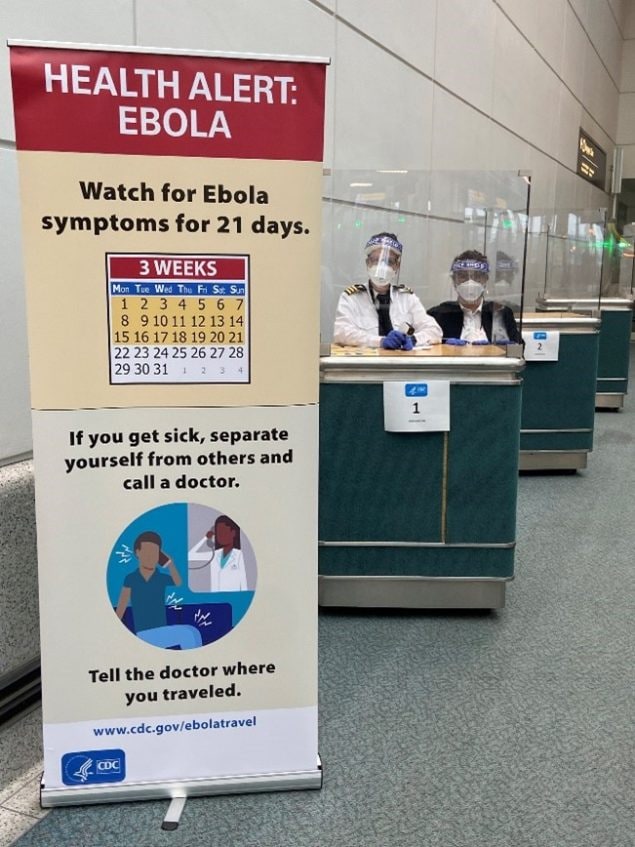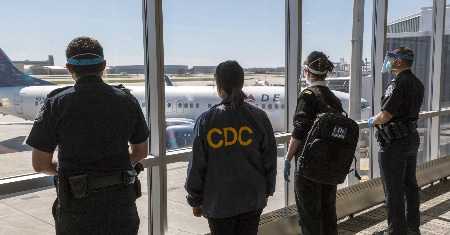Public Health Emergency Preparedness and Response

Today, globalization makes it easier to move people and goods across the world in a short time which means diseases and outbreaks can quickly cross international borders. CDC’s Division of Global Migration Health (DGMH) focuses on activities that lessen the public health risks of rapid global travel.
DGMH meets the challenges of maintaining public health security in a globally mobile world by:
- Using its regulatory authorities to prevent the introduction, transmission, and spread of communicable diseases into the United States
- Preparing for and responding to public health emergencies involving travel or migration
- Protecting public health at US ports of entry
- Keeping Americans healthy during travel
- Promoting the health of migrant populations
- Helping other countries implement public health measures at their own borders
CDC quarantine station staff have the critical job of responding to sick travelers moving through ports of entry. They also monitor certain cargo that might harbor communicable diseases – for example, dogs, human tissues, as well as monkeys and other nonhuman primates. With this infrastructure, DGMH is prepared to expand these services in emergency responses that may require additional public health actions at ports of entry.
DGMH’s Day-to-Day Activities
Protects public health with the support of 20 quarantine stations located at the busiest US international airports, land borders, and seaports, as well as covering over 300 ports of entry across the United States. For example, quarantine stations
- Respond to sick travelers who arrive in the United States.
- Restrict the importation of animals and products that may carry diseases.
- Send lifesaving drugs on the next flight to hospitals caring for patients with diseases such as malaria, botulism, or diphtheria.
- Alert travelers at airports about disease outbreaks abroad and steps they can take to protect themselves and others.
DGMH’s daily work – including the quarantine station network and traveler education – equips DGMH to respond to public health emergencies. DGMH is uniquely positioned and prepared to respond during a major public health emergency by enhancing its normal operations and activities.
DGMH’s ability to coordinate with its network of partners to identify and manage potential health threats, allows the division to prevent disease importation. This network also helps us respond quickly to any infectious disease outbreak that threaten the health of people throughout the world. Keeping people healthy abroad also keeps Americans healthy. Stopping outbreaks where they start and helping countries prevent diseases from spreading across their borders, protects against potential outbreaks in the United States. Here are two recent examples of DGMH’s role in CDC’s efforts to respond to public health emergencies in the United States and around the world.
Ebola

On September 20, 2022, the Ugandan Ministry of Health confirmed an outbreak of Ebola (Sudan ebolavirus) in Mubende District, in western Uganda. This marked the sixth Ebola outbreak in Uganda. Five of the six were caused by Sudan virus species. The outbreak was declared over on January 11, 2023.
During the response, DGMH conducted entry screening and facilitated public health monitoring of travelers to the United States who were in Uganda over the prior 21 days and provided recommendations on steps travelers could take before, during, and after travel. DGMH worked with partners to amplify awareness of the outbreak and enhance preparedness of processes and practices that would be used in the event of suspected or actual introduction of Sudan virus into the U.S. In addition, DGMH’s Global Border Health Team helped officials in Uganda and neighboring countries to better understand cross-border population movement patterns to guide surveillance and collaborative activities.
DGMH Emergency Response Activities
- Posted an Ebola Travel Health Notice for Uganda.
- Displayed health messages to alert travelers about Ebola in Uganda via airport monitors and large banners in English and French.
- Published health information for travelers from Uganda in English and French.
- Conducted public health entry screening for travelers arriving in the United States from Uganda to detect ill travelers and any travelers with high-risk exposures to Ebola.
- Sent health information alert text messages to travelers arriving from Uganda that asked travelers to monitor for signs and symptoms of Ebola. The messages also included information about what to do if the traveler got sick: isolate, call a doctor, and share their travel history.
- Issued guidance and supported U.S. health departments by sharing contact information for travelers arriving from Uganda for public health follow up activities.
COVID-19

DGMH was one of the first programs called in to assist with an outbreak of pneumonia of unknown cause in China in January 2020. Since then, the response to the COVID-19 pandemic, caused by a previously unknown coronavirus, has become CDC’s largest and most complex response to date.
Throughout the response, DGMH has helped protect travelers and other mobile populations and has reduced the public health risk of COVID-19’s spread associated with rapid global travel. Initiatives include providing guidance, recommendations, and requirements; educating travelers and migrant populations; working with international, federal, state, tribal, local, territorial, and industry partners; and protecting the health of immigrants, migrants, refugees, and communities along US borders.
DGMH Emergency Response Activities
- Established public health guidance for domestic and international travelers with potential COVID-19 exposure.
- Published guidance for domestic and international travelers on how to protect themselves and others before, during, and after travel.
- Posted Travel Health Notices to alert travelers and other audiences to COVID-19 health threats around the world and advise them on how to protect themselves — more than 1,000 such notices were posted between January 2020 and June 2021.
- Issued public health orders under its regulatory authorities including
- quarantine orders for repatriated citizens from Wuhan, China (the location of the first outbreak) and passengers from the Diamond Princess and Grand Princess cruise ships, which had COVID-19 outbreaks early in the pandemic.
- the first ever orders to respond to and mitigate the spread of COVID-19 on cruise ships; and
- a testing order for airplane passengers coming to the United States and the first of its kind requirement to wear a mask while on public transportation and at transportation hubs.
- Launched the COVID-19 Travel Planner (a web portal for health departments to enter state or local requirements for travelers) and the Travel Assessment tool, which helps travelers learn about travel recommendations and requirements, make informed decisions, protect themselves, and reduce virus transmission before, during, and after travel.
- Developed extensive messaging, including Travel Health Alert Notices given to international travelers arriving at major U.S. airports, messages on digital airport monitors, public service announcements for travelers, toolkits for road travel and airline partners, and resources in more than 30 languages to reach people in their native languages.
- Worked to protect newly resettled and long-term resident refugees, immigrants, and migrants, including agricultural workers, and to provide them with culturally and linguistically appropriate resources.